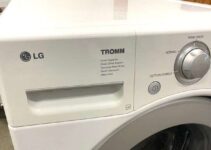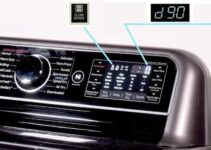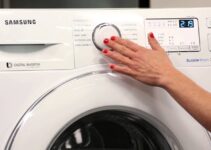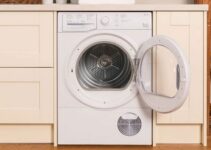When your GE washing machine’s spin light is blinking endlessly, this usually means there is a fault in the washing machine that prevents it from spinning.
The indicator light is designed to inform you of such faults so you can address the issue and prevent further damage to the washing machine.
In this guide, we’ll explain the causes of the “GE washer spin light blinking” problem and the fixes to apply.
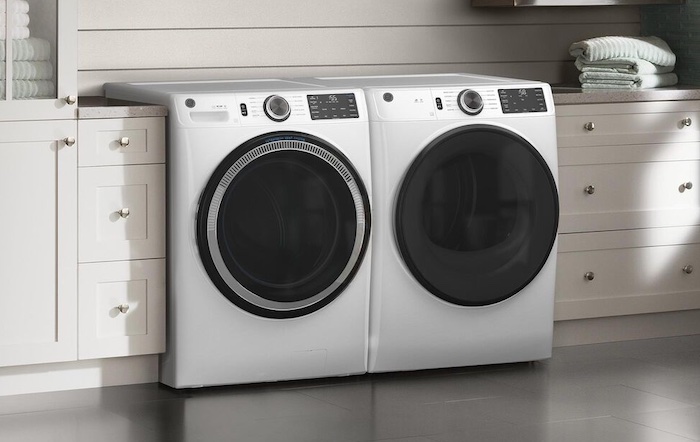
GE Washer Spin Light Blinking: Likely Causes
- Unbalanced Load
- Worn Tub Bearings
GE Washer Spin Light Blinking: Fixes
Check the load
To fix an unbalanced load in your GE washing machine, follow the steps…
- Turn off your washing machine’s power supply to prevent any incidents
- When done, open the door of your washer and check the quantity of clothes in the drum. You need to check and confirm that the drum has not been filled past 3/4. If the quantity of clothes is more than acceptable, it means the drum is overloaded and could be the reason your washing machine won’t be able to spin properly.
- If the load is balanced, check that your washing machine sits on a firm, even surface. If you notice that the washer is tilted at an angle, the weight of the clothes would be spread unevenly causing an unbalanced load.
- Once you’ve completed the checks, turn on your washer’s power supply and run the spin cycle again to see if the issue has been solved.
Check for worn tub bearings
If the problem still persists, it could be due to worn tub bearings. You can replace the GE washers tub bearings following the steps below.
- Start by turning off your washing machine’s water and power supply to avoid water leakage and electrocution. Then disconnect the water inlet hoses from the back of your washing machine.
- Using a screwdriver, take out the screws at the back of the control panel, then slide the control panel to the side to detach it from the main top of the washing machine.
- Detach the wires from the control panel and set it aside.
- Using a flat-head screwdriver, release the clips holding the front section of the washer and pull the front panel off the washer.
- Take out the two screws at the front of your washing machine holding the main top panel and slide the panel before lifting it up.
- You should be able to reach under the top panel. Using a pair of pliers, release the lid switch wire retainer from the cabinet
- Open the lid of your washing machine and reach under the tab. You need tpo squeeze the tab on the lid switch to release it.
- Push the lid switch through the opening at the top. Turn the lid switch sideways and push it back through the opening.
- Remove the main top panel from the washing machine completely and use the screwdriver to take out the screws on the control panel bracket, trim, and rear panel.
- Using a pair of pliers, remove the air pressure tube from the water pressure switch.
- Using your screwdriver, remove the screws holding the shock dampening straps to the tub cover, then you need to pull the straps off.
- When done, release the tabs at the bottom of the tub cover. You should now be able to pull the cover off the tub.
- Take out the dispenser cap and rotate the cup counter-clockwise to remove the washer’s tub.
- Remove the agitator bolt and pull the agitator out of the washing machine, then pull the drive block and washer off the agitator shaft.
- Remove the tub nut using and lift the inner tub off the drive shaft and set it aside.
- Use a flat-blade screwdriver to take out the split ring off the drive shaft and lift the washer nut out.
- You need to remove the mode shifter and motor wires from the drive motor and remove the drive motor grounding wire.
- Using a pair of pliers, take out the wires from the drive motor mounting bracket and untwist them from the suspension rod.
- With a screwdriver, take out the screw holding the drain hose to the tub of your washing machine.
- Remove the hose off the tub and disconnect the air pressure tub from the side of the tub and detach it from the retainer.
- You need to release the four suspension rods from the base frame. To do this, lift the tub slightly. After that, tilt the tub and motor assembly forward and pull it out of the cabinet.
- With the tub out, lay it on the ground and turn it upside down. After that, release the drive belt from the bottom of the tub.
- Remove the nut holding the drive pulley, then lift the pulley off and remove the hex bolts underneath.
- Using a socket wrench, remove the bolts holding the base frame to the outer tub then cut the zip-tie holding the overflow tube to the base frame. This should free up the base frame assembly so you can lift it off the outer tub.
- Take out the mode shifter and shaft assembly out of the tub and pull the nylon washer off.
- This should give you access to the tub bearing, you will need a screwdriver to remove the screw holding the bearing.
- Fix then new tub bearing into the opening at the bottom of the tub and reapply the screw.
- Return the nylon washer on the new tub bearing.
- Place the shaft and mode shifter assembly through the opening at the bottom of the tub and align the base frame with the mode shifter and outer tub.
- Using your socket wrench, reapply the base frame bolts and get a zip-tie to secure the overflow tube to the base frame.
- Secure the mode shifter by applying the hex bolts, then put the drive pulley back on and reapply the nut to secure it.
- Loop the drive belt back around the motor shaft and drive pulley as you had removed it.
- Put the tub and motor assembly back inside the cabinet (ensure that the motor is facing forward.
- Lift the outer tub and snap the four suspension rods back in place on the base frame.
- You will have to reconnect the air pressure tube and use the retaining wire to secure the tube to the suspension rod.
- After that, connect the drain hose back to the bottom of the tub and screw it in place.
- Wind the motor wires you had previously removed around the suspension rod and snap all the retainers in place. Return the screw to secure the grounding wire.
- Connect the mode shifter and motor wires to the drive motor and return the washer nut and split ring back on the drive shaft.
- Align the inner tub on the drive shaft to get it back in place.
- Return the tub nut back in place and thread it counter-clockwise, then return the washer and drive block on the agitator shaft.
- Place the agitator in place and secure it with the bolt.
- Return the soap dispenser cup and turn it clockwise to secure it. After that, snap the tub cover back in place.
- Connect the shock dampening straps back to the tub cover and apply the screws to secure them.
- Return the control panel bracket and apply the screws to secure it, then reconnect the air pressure tube to the water pressure switch.
- Return the control panel trim and rear panel and secure them with the screws.
- Insert the lid switch through the space in the main top panel, then snap it in place.
- Return the wire retainer into the frame. After that, push the main top panel back in position. Use the screws at the front to secure it.
- Snap the main front panel of your washer back in place.
- Reapply the electrical connectors to the control board and return the board to its original position. Secure it with the screws.
- Finally, connect the water inlet hoses back to your washing machine.
When done, you need to check to see if the Spin Light indicator has been fixed. Simply, turn on the washing machine and run a spin cycle.

